11 Best Practices for Working Remotely
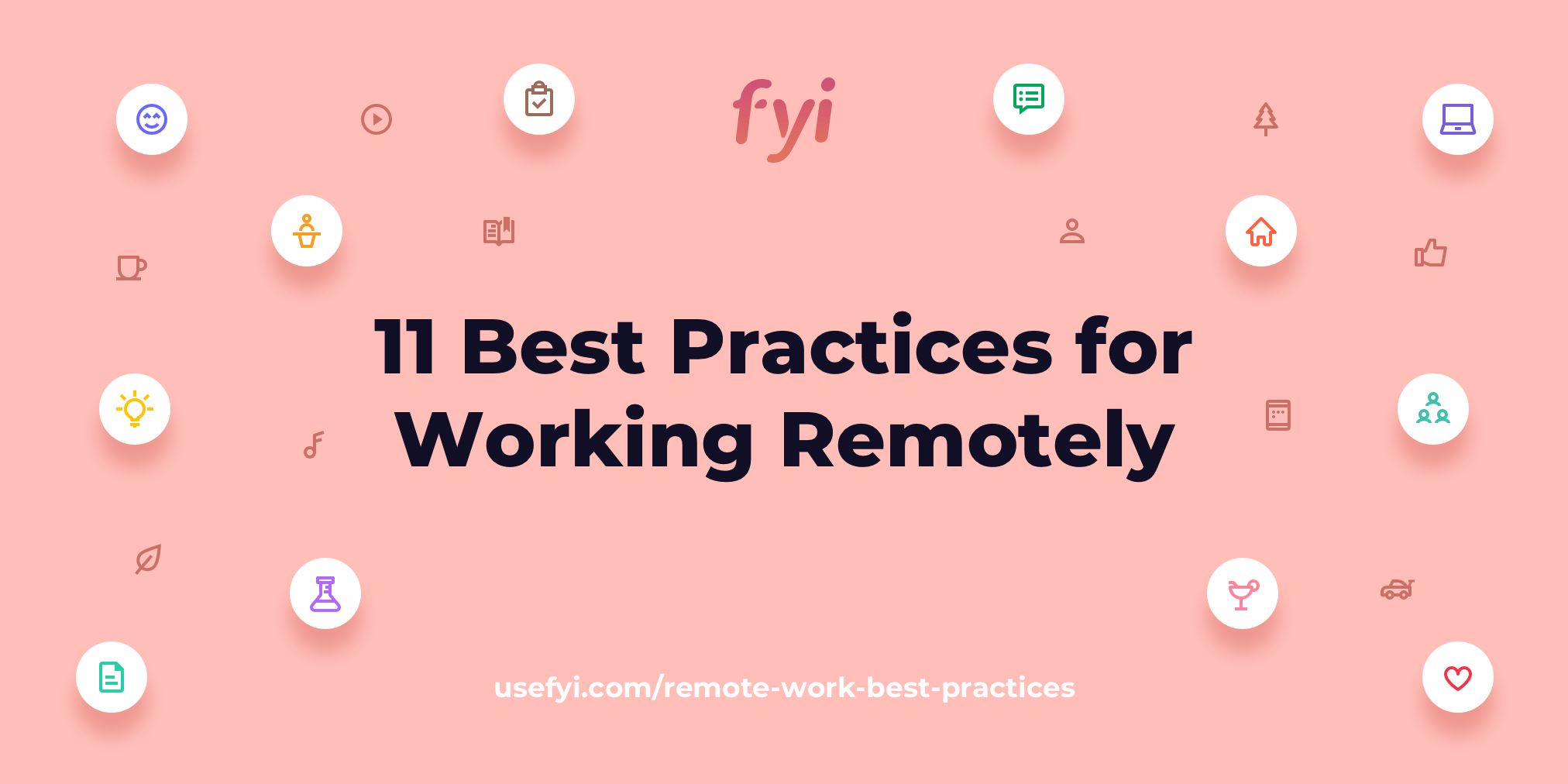
There’s no one-size-fits-all formula for remote work. Everyone has different ways of working. Different times at which they work. Different work locations. Different time zones.
Even though the rise of remote work isn’t a new trend, many people are still figuring out how to work remotely through trial and error, doing their best to stay happy and productive. The challenges exist both for those who are remote work veterans and people who are just getting started.
And it’s not just people, entire companies struggle at making remote work, too.
What’s the key to getting remote work right?
At Nira, we wanted to understand everything we could about working remotely. Including its challenges, how people feel about it, and the best ways to work remotely. Plus people’s tips and best practices for working remotely.
So we surveyed almost 500 people about remote work and put our findings together in the Remote Work Report.
We had a hunch before we did the research that in spite of the challenges with remote work, people loved it. We were right, except we underestimated just how much people love remote work:
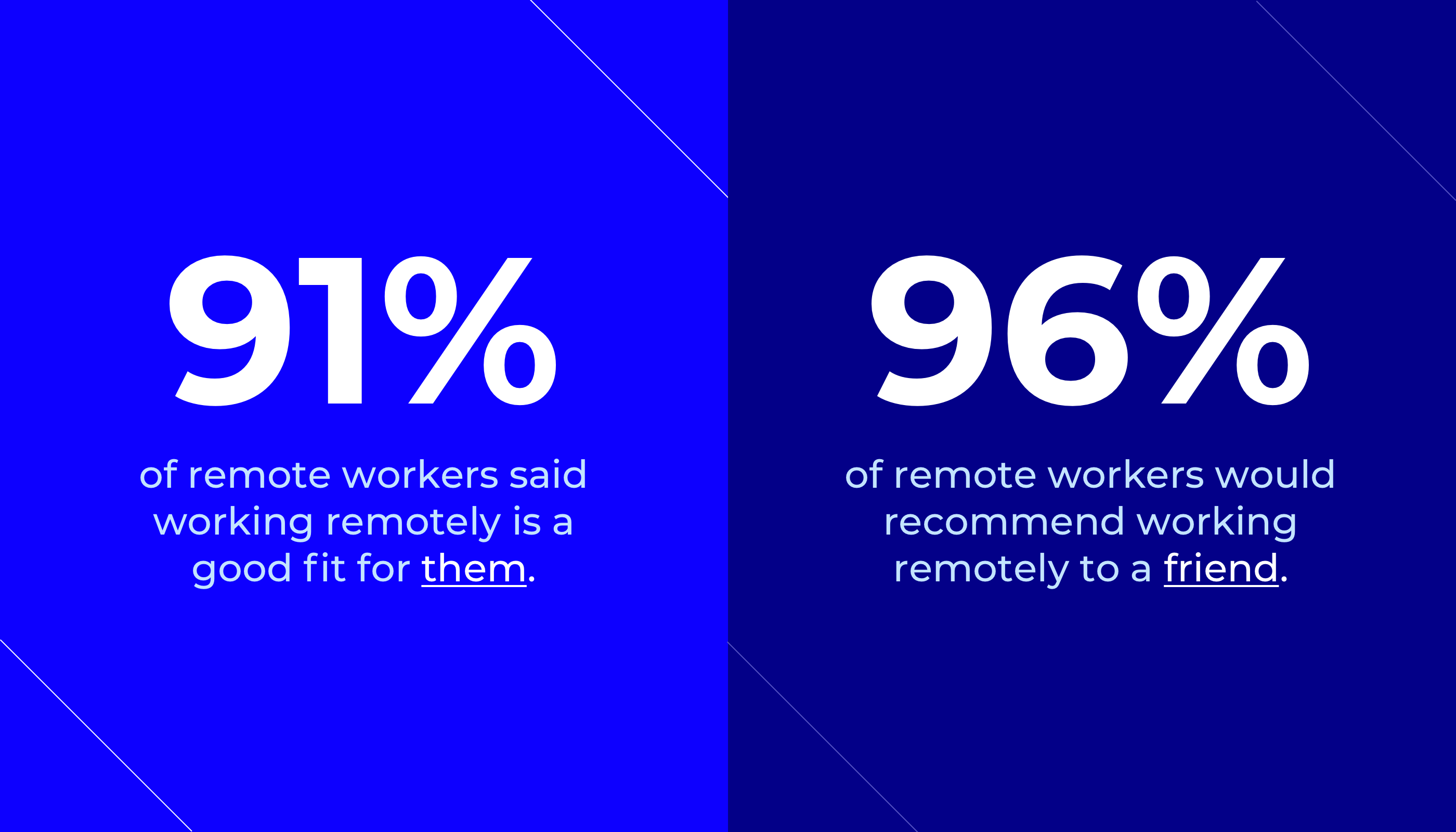
Why do people love remote work?
It’s the flexibility. The lack of commute. The reduction of distractions. The ability to travel and live anywhere, including outside of major cities. The increased productivity. And of course the ability to be closer to one’s family.
But even though most people love working remotely, remote work has a lot of challenges. It’s easy to fall into many of the traps of remote work, especially if you’re new to it.
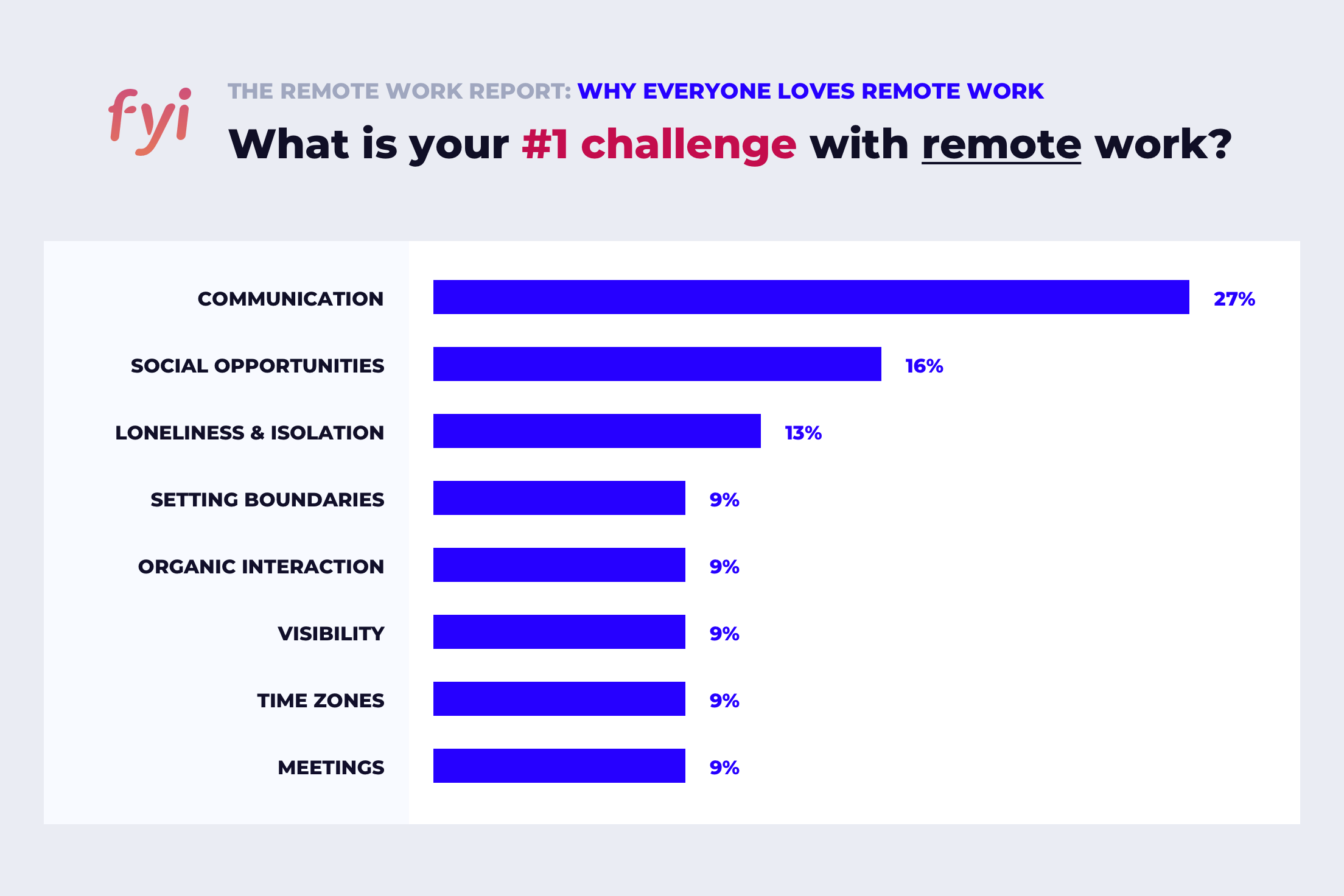
We asked people “What is your #1 challenge with remote work?”
- Communication topped the list, with 27% of people mentioning it as their #1 challenge. Remote work makes it harder to read body language, hear what people are saying, ask follow-up questions in the hallway, or quickly ask a coworker for clarification at their desk.
- Lacking social opportunities was the second-largest challenge cited by participants. Office culture doesn’t exist when there’s no office. That’s why people struggle with the lack of social opportunities, like grabbing drinks with coworkers.
- Loneliness and isolation were the third most-cited challenges. Sitting at home alone day after day can leave you sapped of energy and feeling down. A few survey participants even mentioned not quite feeling like they were part of the company.
How to thrive as a remote worker
With some consistent effort, you can overcome the challenges of remote work and create a healthy, happy, productive environment for yourself and for your team.
Here are 11 ways to ensure you succeed at remote work in spite of its challenges based on everything we learned. You’ll find tips and best practices from people who are working remotely, plus personal advice from my co-founder Hiten and me.
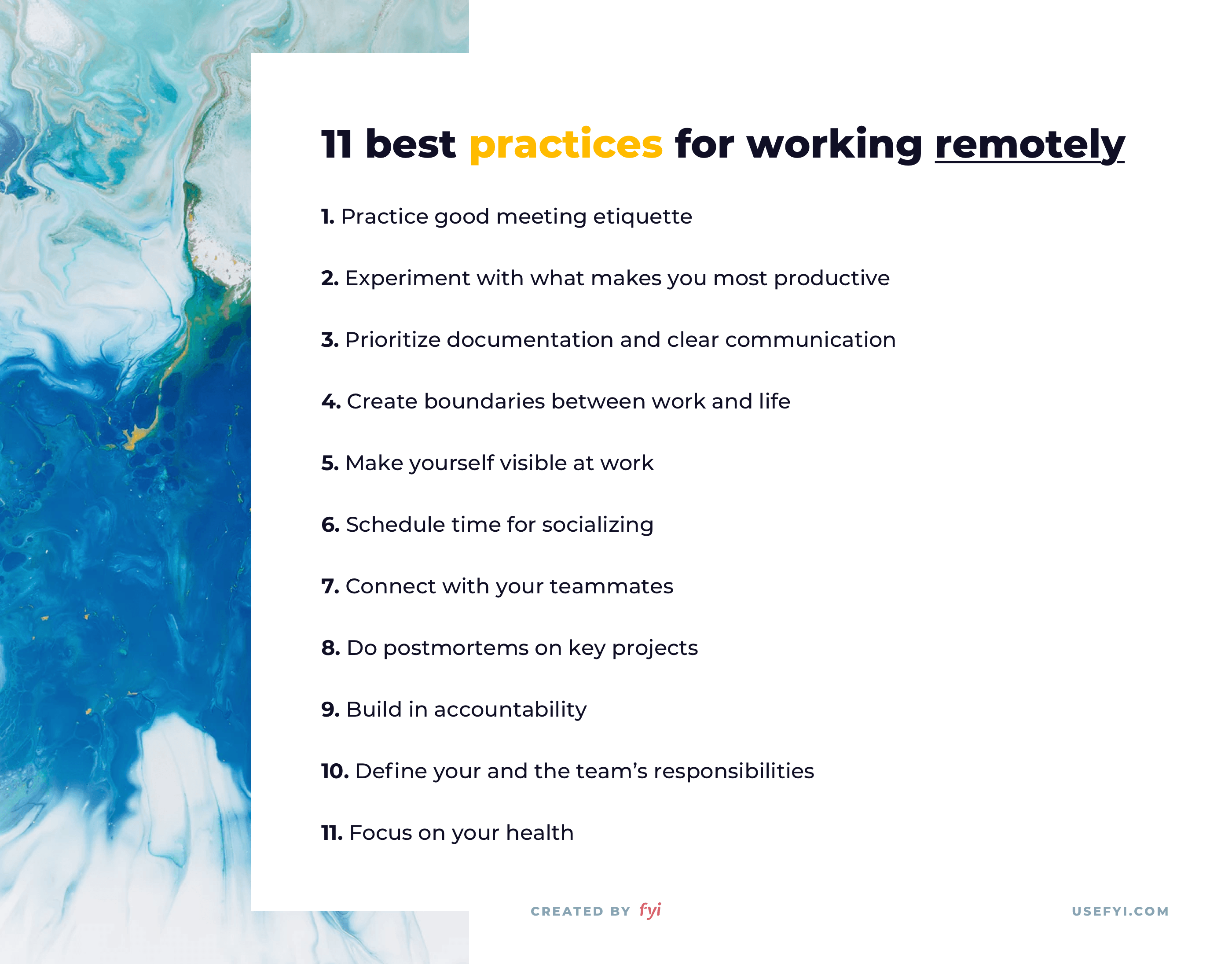
- Practice good meeting etiquette
- Experiment with what makes you most productive
- Prioritize documentation and clear communication
- Create boundaries between work and life
- Make yourself visible at work
- Schedule time for socializing
- Connect with your teammates
- Do postmortems on key projects
- Build in accountability
- Define your and the team’s responsibilities
- Focus on your health
1) Practice good meeting etiquette
In person, it’s easy to see if someone is checked out during a meeting. They fiddle with their pen, start reading emails, maybe even begin to doze off. But when calls happen remotely, it’s much more difficult to see the telltale signs of disinterest.
Without video, people could be doing anything on the other end of a call—from making lunch to petting their dog to working on something else. That’s one reason why having cameras on for all remote calls will help keep you and everyone else on the call alert and engaged.
Be sure to set up a free account with GoToMeeting if you don’t already have a video conferencing service.
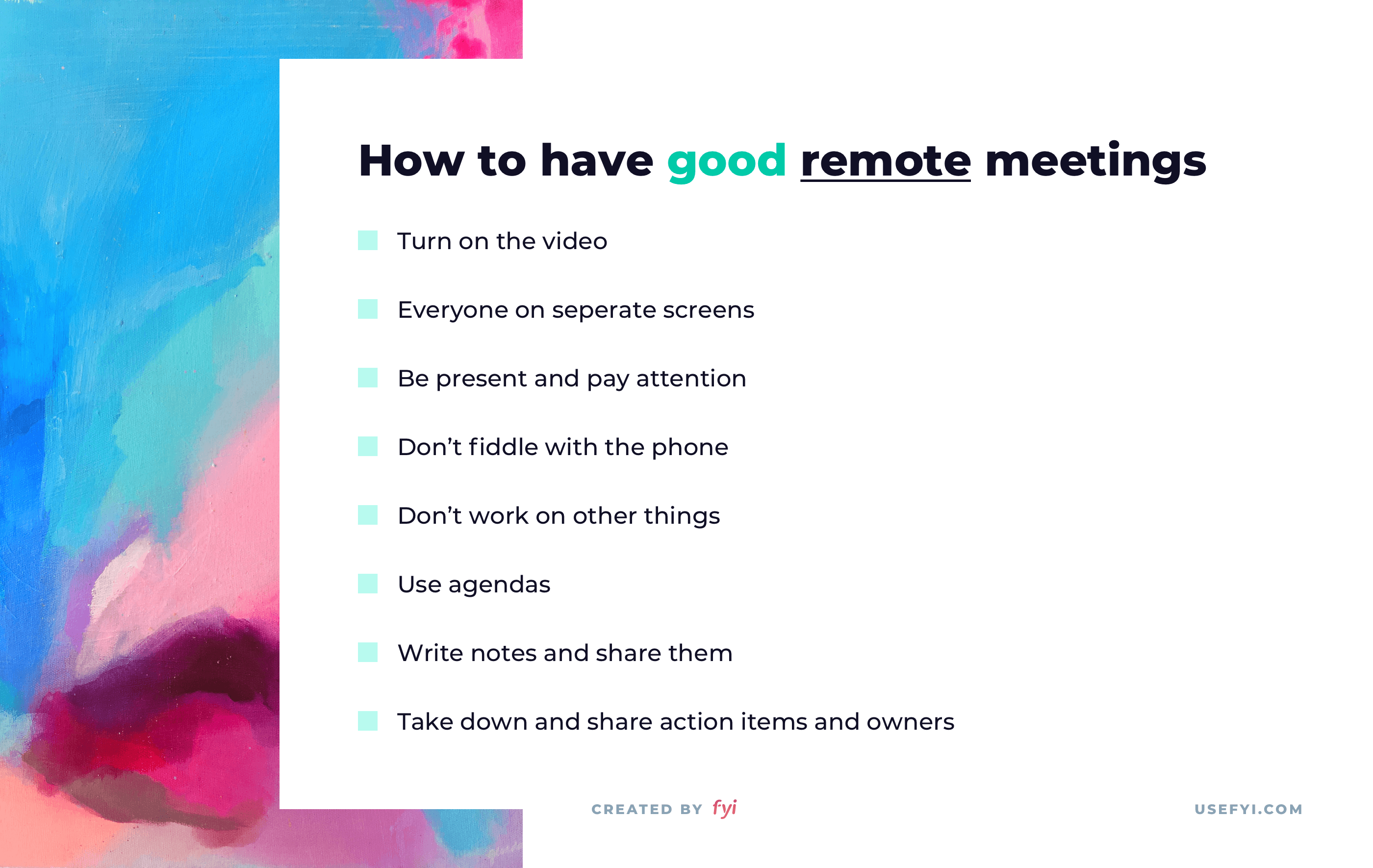
That’s the #1 key to having good remote meetings: simply turn on your camera.
“Always use video in conference calls. People tune out when it’s an audio-only call.”
Stephane Kasriel, CEO of Upwork
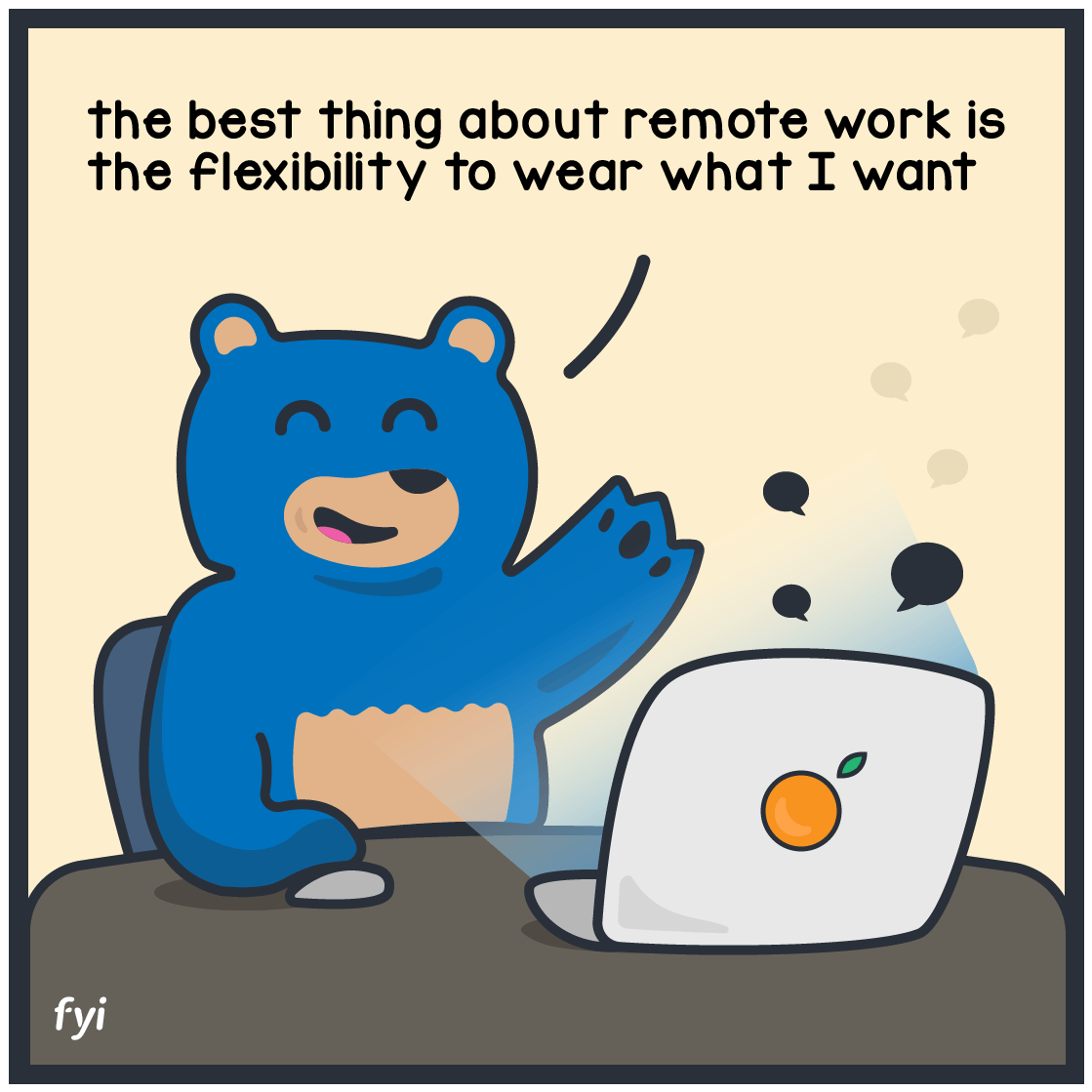
Since your video will be on, make sure to wear a shirt and pants. It may sound ridiculous to call this out, but there are too many embarrassing remote work stories about people showing up to meetings on video without enough on, like this one from our report:
“Meeting with a client who shows up on the Zoom call in the bathroom—not wearing much…. 😩”
Having video on doesn’t just connect you with the team (and show everyone what you’re wearing), it keeps you on good behavior and paying attention.
Do your best to avoid working on other things or fiddling with your cellphone when you’re on a video call. Hearing someone typing during a call or seeing them stare at another project on their screen can feel disappointing for everyone else on the call. Plus the person is probably missing what’s going on.
“Have your video on even during even casual/simple meetings. Enabling video goes such a long way to help everyone feel more together, communicate better, and trust each other (even when you’ve mastered remote communication).”
Nikhil Nik Kundra, Co-founder & CEO of Partender
How should we handle video calls with teams that have an office and remote folks?
If one person is remote, everyone is remote.
A team with some people in a single location and others who are remote should treat meetings as if everyone is remote. That means everyone should call in from separate rooms/spaces.
“Even if people are in the same physical space (e.g. conference room) do all the meetings through the same video chat (we use Zoom). Why? Equalizes the experience—no muffled voices because the speaker is too far, or off camera banter that leaves out the remote person.”
Everett Harper, CEO & Co-founder of Truss
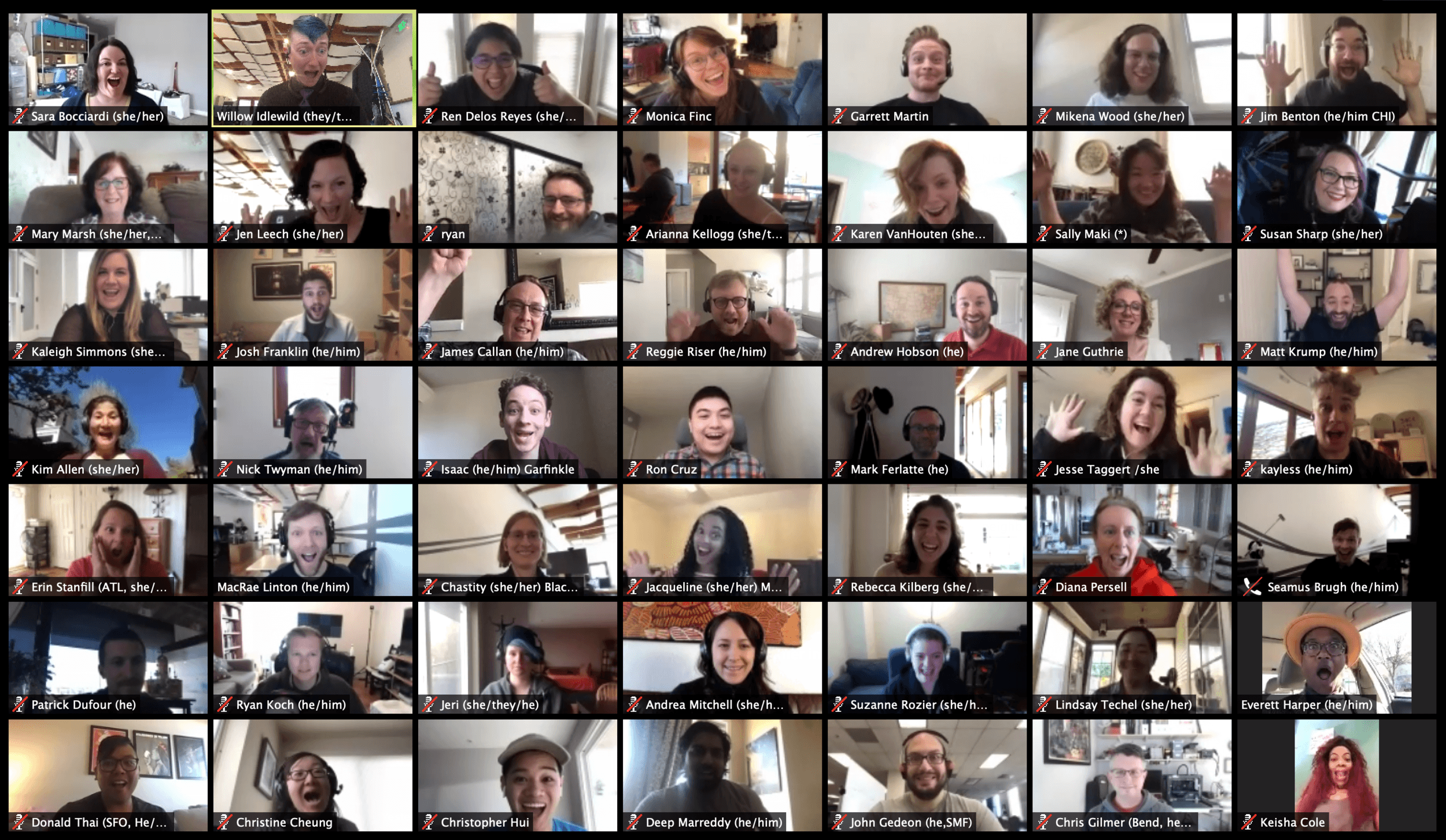
2) Experiment with what makes you most productive
It’s easy to fall into the trap of thinking you should be able to sit down at your home office desk in the morning and seamlessly crank out work until nightfall. But without the built-in discipline and natural breaks of an office, things can easily fall apart.
It’s up to you to build the best way for yourself to work remotely.
When we work in an office, we take walks to get snacks, chat with coworkers, take coffee and tea breaks, and make time to have lunch away from our desks. But at home, somehow these natural things start to feel as if we’re cheating or slacking off.
Suddenly, people are working more hours with fewer breaks, all from the same exact place every day. This is almost certainly a recipe for disaster and burnout.
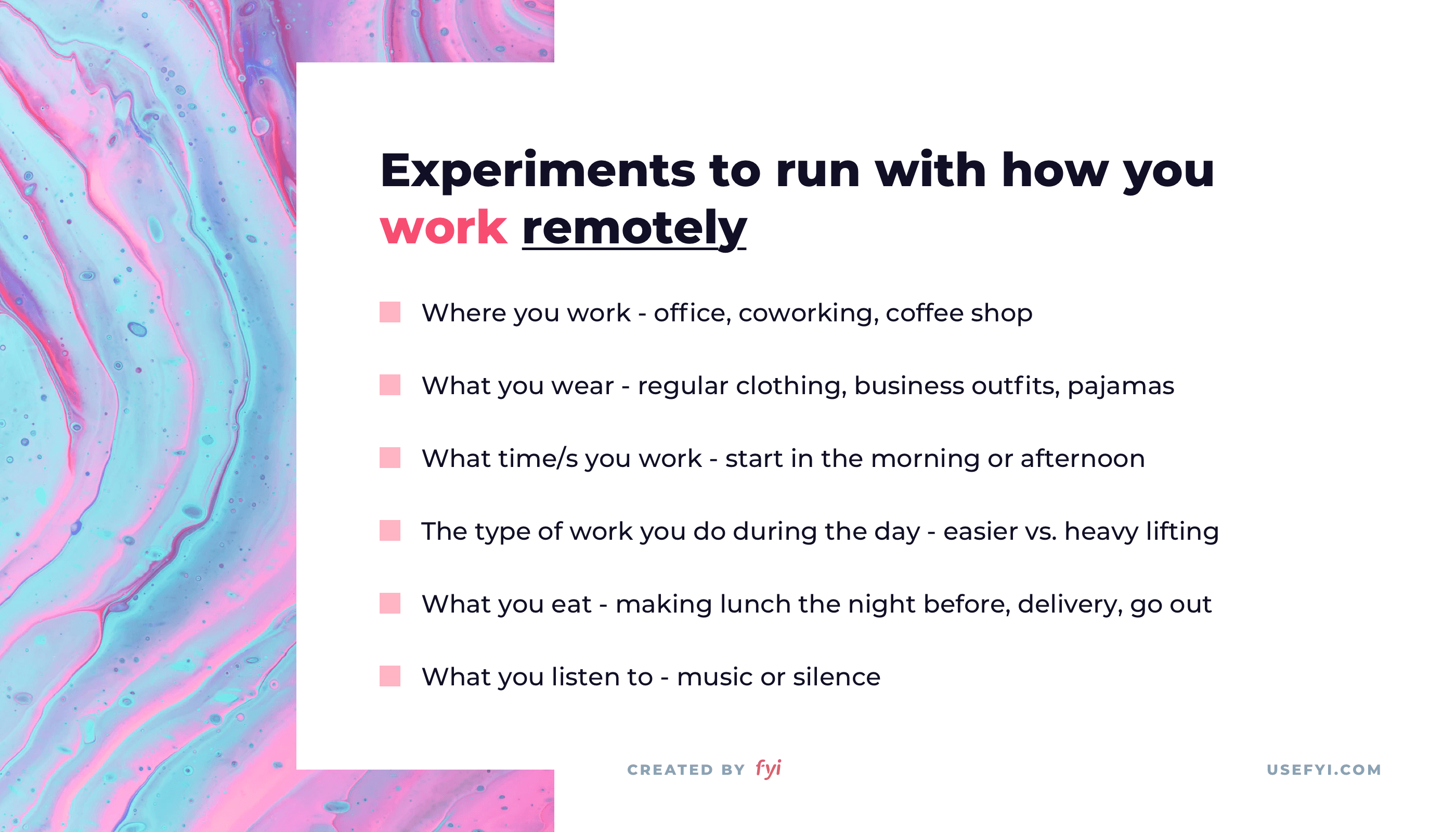
The best way to escape this trap is to experiment to find the best way that you work. Give yourself permission to try different start times, work from different places, and wear different types of clothing.
“Experiment to find what works best for you. Home office, nomad, music, silent, dress up or PJs, we all work differently. The beautiful thing about remote work is you have the flexibility to find your perfect setup.”
Sarah Betts, Customer Champion at Olark
Things like the temperature of your workspace, your audio setup (headphones, earbuds, microphone), the comfort level of your chair, and the desk you use can all mean the difference between productivity and distraction.
You should also consider the times when you are most productive and want to do independent work, and when you should do less intellectually stimulating work.
“Splitting the day in deep and shallow work. I usually spend my mornings doing deep work, and I spend the rest of the day doing shallow work.”
Amir Salihefendić, Founder of Doist
If you know you’re more productive after taking a long walk with your dog halfway through the day, you should do that.
Try different ways of working, different break times, and working from different places to learn what’s best for you.
3) Prioritize documentation and clear communication
Communication dynamics for remote workers are totally different than those for people who are together in an office.
The days of walking over to someone’s desk anytime you want to clarify something are over. Suddenly you’re dealing with multiple time zones and communication over Slack and video. Not to mention poor video and audio connections, which is the #1 challenge people have with remote meetings.
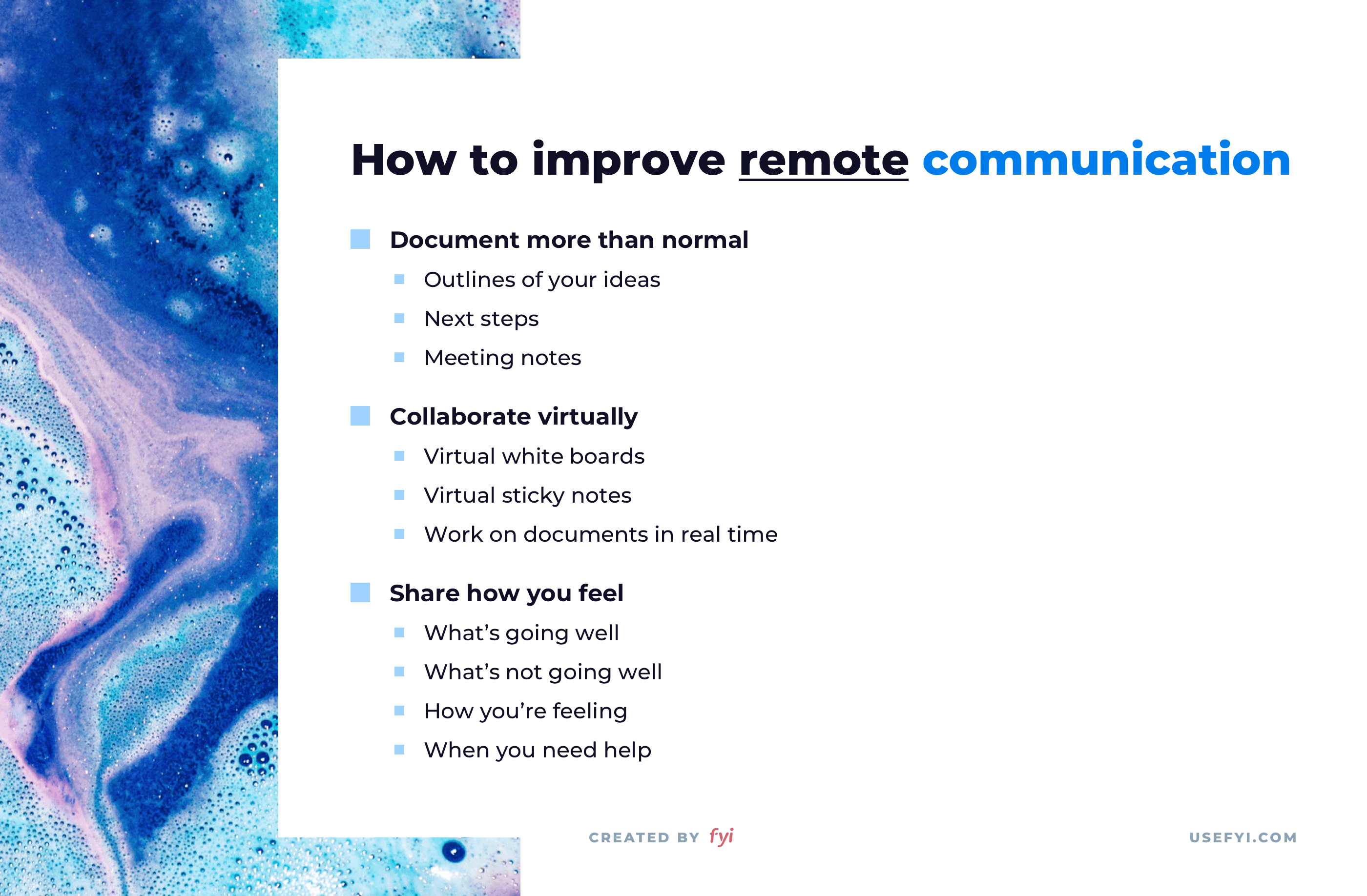
Remote work requires purposeful and planned communication. Otherwise, things can get misunderstood, or never communicated in the first place.
Make sure to document more than you would normally. For example, create documents to outline your ideas and align on next steps. Those documents will make sure that everyone is on the same page.
“Document more. Use asynchronous collaboration tools whenever possible (e.g. Jira, not Slack).”
Stephane Kasriel, CEO of Upwork
Write down as much as you can when it comes to your work. You’ll have a much happier time as a remote worker.
At Nira, my co-founder Hiten and I create more documents than we can count. All to ensure that our ideas and what we’re working on are communicated properly to one another and to the rest of the team. We also have the added benefit of using our product to keep them organized and secure, too 🙂
“Overcommunicate on Slack/email and record as many meetings as you can (and share those on Slack for others to consume). Disseminating information is a major contribution in a remote environment. Remote teams which write clearly, succinctly and with enough context can minimize back and forth while maximizing understanding.”
Ben Erez, Product Manager at Abstract
It’s important to go beyond simply documenting. Make sure you share what you’ve written and discuss it with your team, either in your team’s chat app or on calls.
If you feel drawn to, try collaborating using virtual whiteboards. They’ll help you collaborate in real time in a much more visual way than with a regular document. One tool that can help you do this is virtual whiteboarding product Miro.
It’s also important to communicate how you’re feeling. It’s easy for people to see you in an office and notice that something is going really well, or really poorly. But working remotely makes it difficult to spot when something is off. That’s why it’s essential that you speak up. And if you’re a manager, ask the team how they are doing often.
4) Create boundaries between work and life
Boundaries between work and life get blurred for remote workers. Since many of us work from home, suddenly the work environment and the home/life environment merge into one never-ending entity. Wake up, check your email, sit down for breakfast while working, keep working throughout the day, suddenly it’s 10 p.m. and we’re still working.
I’m personally guilty of this remote work sin. As is my co-founder (don’t ask him when his last true vacation was).
This can be extremely unhealthy.
Unplugging is important. To do this, as a remote worker you’ll need to create boundaries that help separate work from regular life. Or else, potentially pay the price of burnout, social isolation, and even depression.
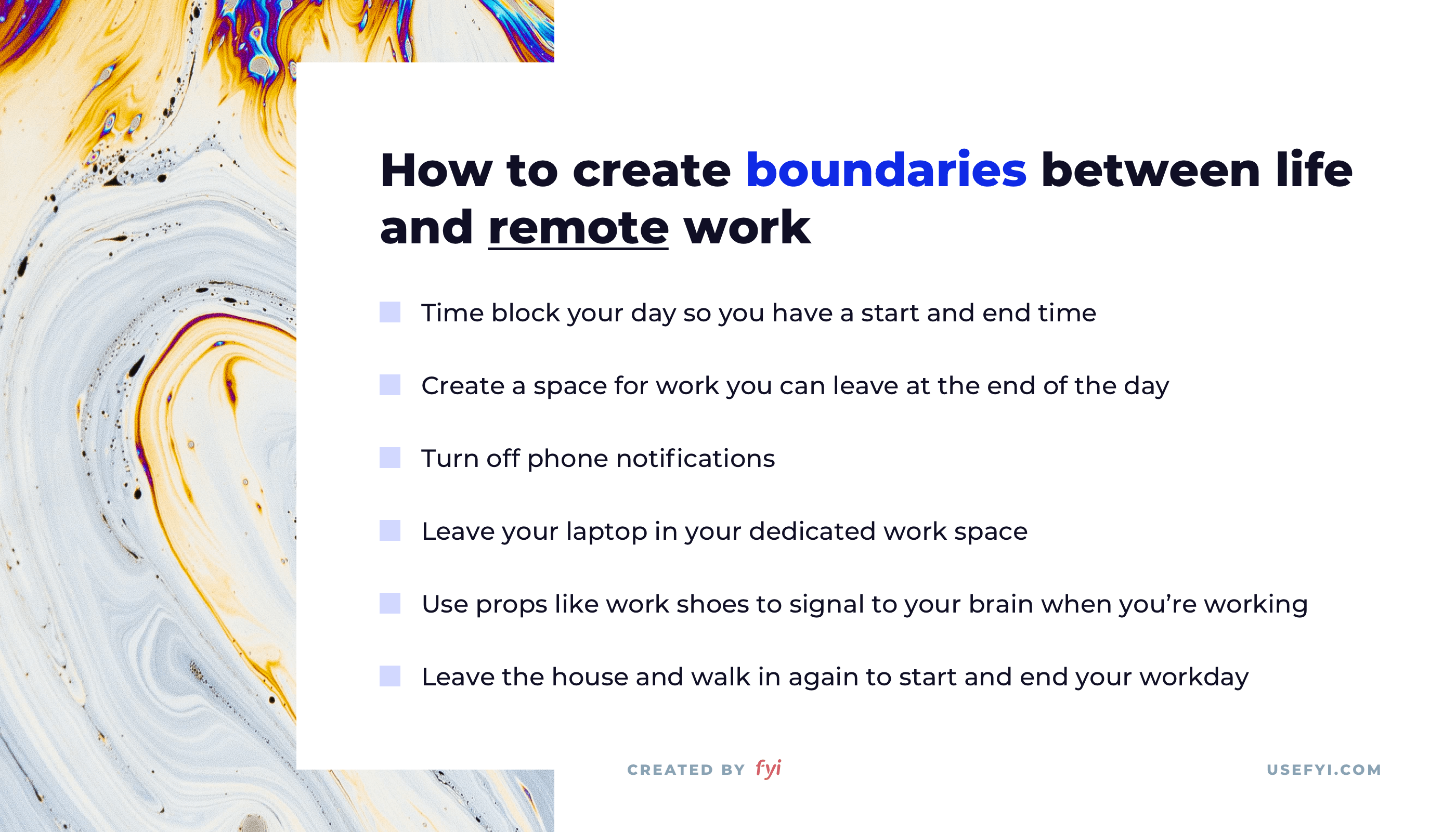
Decide when you’re working, and stop once your day is done. That way, you won’t work from sunup to sundown.
One way to create boundaries as a remote worker is by creating a special workspace that you can physically walk out of. For people who live in cities with limited apartment space this can be difficult, but if possible, having a separate office with a door that closes can help tremendously in creating boundaries.
“Having a completely different room/area that is a designated ‘work zone’ that you know if (a) you are in it, then you are 100% committed to working and (b) if you are outside it, then you switch off completely and do ‘real life’ stuff.”
Devan Sabaratnam, Creator & Co-founder of HR Partner
Another hack is getting distance from your work electronics. Turn off your phone and computer work-related notifications in the evening and on weekends. Even put your work devices out of reach. I also have much more about this tactic in a post I wrote about Marie Kondoing your digital life.
“I recommend turning off notifications on your phone, keeping your laptop in an office, and overall creating rules that work with your life so that you can still relax at home and avoid feeling like you’re always working.”
Hailley Griffis, Head of Public Relations at Buffer
You can also use a physical object to help your brain realize that work is done for the day. Like a work hat or work shoes (or fuzzy slippers).
“Have a special pair of “work shoes” that help literally and figuratively signify when you’re working and when you are not to help with boundaries.”
Max Lind, Manager Field Marketing / Designer Evangelist at Abstract
Or, you can go even more out of the box and literally walk out of your house and walk back in when it’s time to start work. Then do it again when you are done with your workday. Anything to trick your brain into separating work and regular life.
There is another side to boundaries that’s worth mentioning. Since you work from home, sometimes family and friends think that means you are always available. If this is the case, you may need to set boundaries with them too by explaining your availability to them.
5) Make yourself visible at work
When you have an office, you’re constantly visible to others. This can be bad (you’ve got a hangover, you weren’t able to get any sleep) but typically, it’s quite good.
Your boss sees you on the regular and asks what you’re working on. You’re on people’s minds because they bump into you all the time, so they invite you to meetings and set up time to chat. People drop by your desk and say hello. You run into the CEO and give her a quick elevator pitch of what you’re working on.
Remote doesn’t have this luxury.
Outside of meetings, we’re reduced to a name on a Slack sidebar. Unless we take action to become visible.
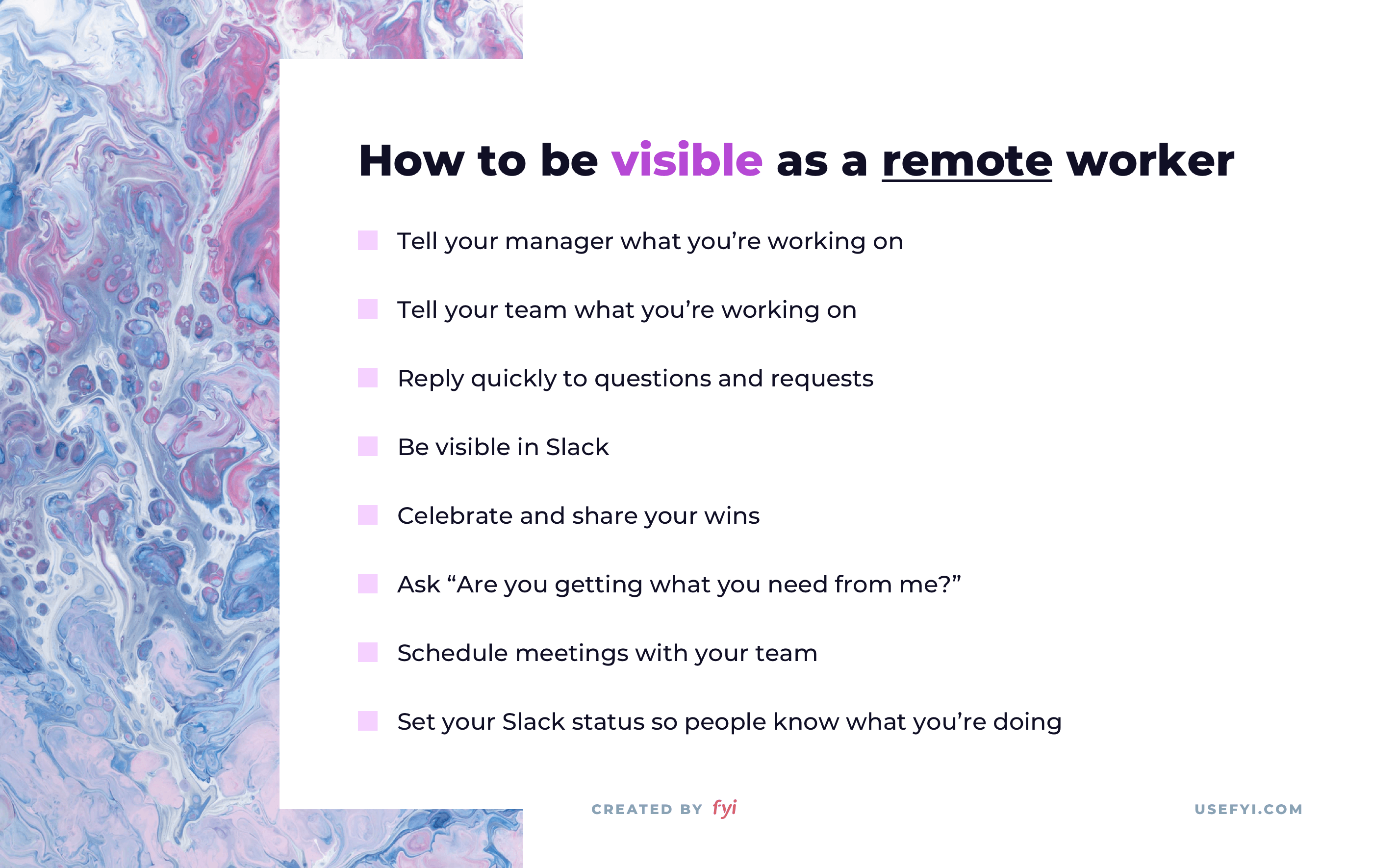
A simple but highly effective way to stay visible is to let people know what you’re working on. It’s natural for your teammates – and even your manager – to get caught up in their own day-to-day. So it’s up to you to remind them about what you’re doing (and frankly, your existence).
“Be prompt when someone asks you questions. Even if you’re busy with something else, reply to them and let them know you’ll get back to them within a certain time, so that they’re not just waiting around unknowingly, instead they have clarity on when you’ll be getting back to them.”
Ritika Bhagya, Founder & UX Director at PT. Studio Flolab
Being responsive as quickly as you can is another form of visibility. If someone asks you a question, whether it’s in Slack, Microsoft Teams, or in a comment in a document tool, the faster you get back, the more visible you can seem. That’s not to say you should constantly be available at all hours and be open to interruptions, but quick responses can help people see that you’re hard at work.
There are lots of ways to stay visible virtually, like being active in Slack, setting up meetings with people on your team, even sharing documents before and after meetings (like notes and agendas). All of these things keep you top of mind to others on your team.
“Although you have a job definition and goals, you do not have the luxury of working in an office and getting a ‘feel’ for if you are achieving the right objectives. Be sure to check in with your manager and if you’re managing direct reports be sure to ask “Are you getting what you need from me?” This will foster a conversation around objectives and ensure both the employee and employer are getting what they need!”
Tiffany Heimpel, Director of Sales at Dribbble
Getting feedback on your work is another form of visibility. And it can be tougher to come by for remote workers since you have to explicitly ask for it much of the time. So ask for feedback, early and often.
6) Schedule time for socializing
Alone at home. Working all day. Wearing fuzzy remote work slippers. Sipping tea while petting your dog (or cat). All these things lend themselves to not going out once your work is done. You’re so comfortable, why disturb the peace by leaving the house?

When you work remotely, you miss out on the built-in social benefits of an office, and can easily descend into madness.
Unless you purposely create a social agenda and time to connect with other human beings in person. Like your friends.
This is especially true since, contrary to popular belief, most remote workers are not introverts.
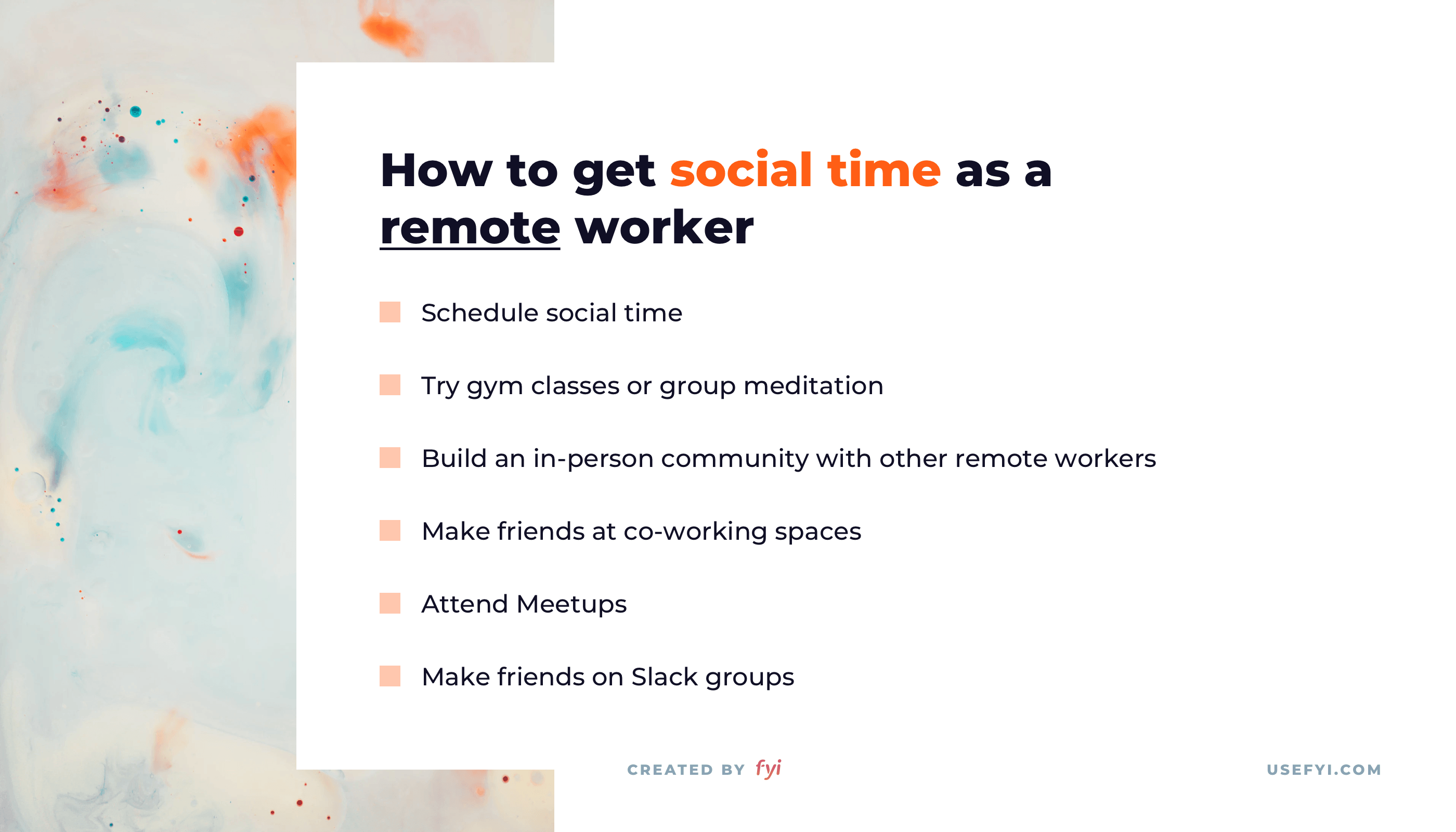
“Keep a regular social calendar. I play poker with the guys twice a month and I do a happy hour with friends once a month. You need to get out and interact.”
Greg Digneo, Writer at Time Doctor
You can also create a faux office culture by connecting with other remote workers in person.
“Being remote might mean that you don’t have work friends to share that after-work drink with. Find other remote workers to build your own in-person community. Co-working spaces, meetups, and slack groups are great places to make friends.”
Vivian M. Chen, Founder & CEO of Rise
Whatever activities you choose, whether it’s time with friends, gym classes, meetups, coffees with people from your co-working space, make sure to actually do them. Put them into your schedule. Ask people to hang out. Ditch the slippers and force yourself to get out of the house.
“You must be proactive in setting aside time to see people! When you’re remote, you have to be the one to schedule coffees and lunches! Weird at first but get out there!”
Sibi M., Startup Advisor

7) Connect with your teammates
Getting to know your teammates beyond just work will help you feel connected, be more productive, and feel happier at work. Even if you mostly work alone, feeling connected to the team will help you enjoy the work you do.
Without that connection to your team, you can begin to feel isolated, alone, even unhappy.
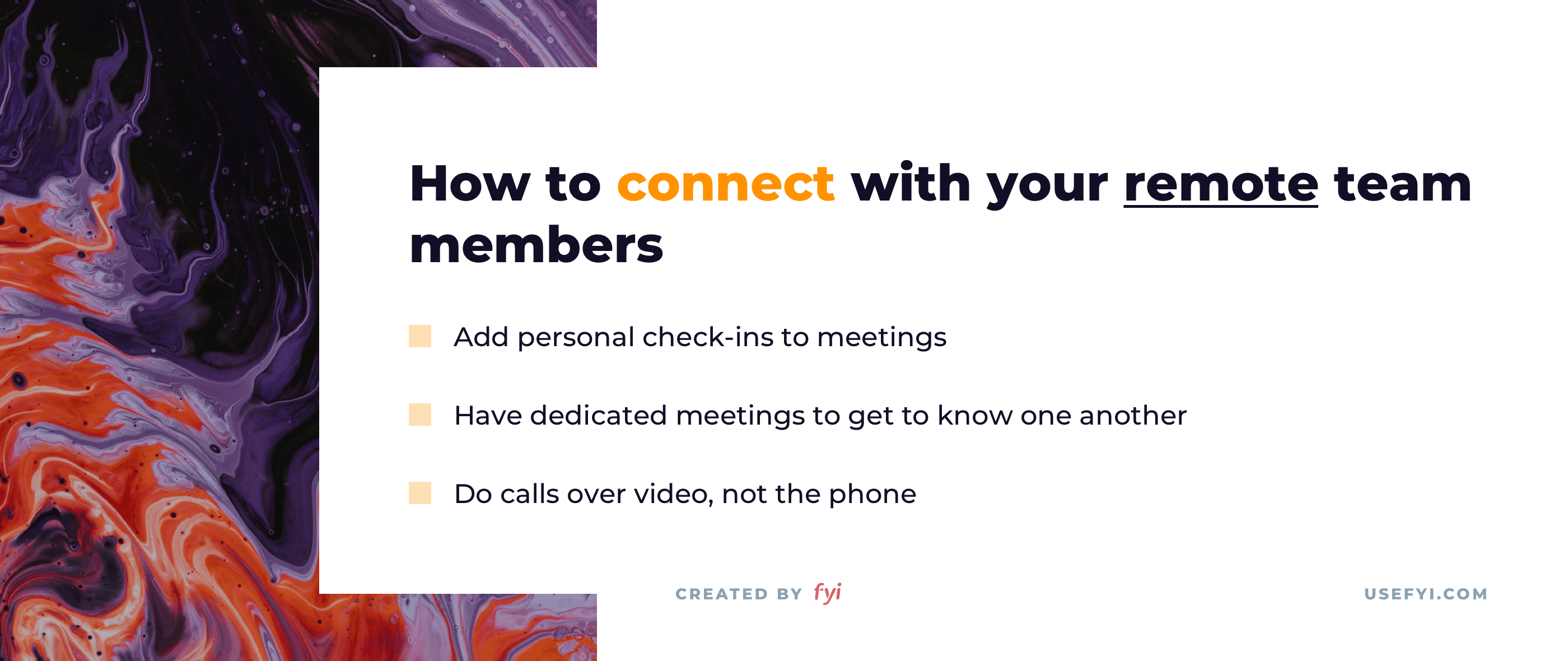
If you’re able, don’t just rush into work when you get on a call. Spend at least a few minutes catching up and see how everyone is doing. The more you can learn about your teammates, the happier you’ll be that you’re working with them.
“Start all meetings with personal check-ins. We do rose, bud, thorn; red, yellow, green; and others. Building personal relationships remotely can be hard, but mutual trust and care are essential to high-performing teams. There’s no “watercooler,” so you have to make one.”
Jeff Whitlock, Founder & CEO of Unbird
You can also dedicate entire meetings to getting to know one another and catching up on things outside of work. Virtual teas/coffees or drinks can work well for this.
Another way to get to know one another is through photos. For example, you can share family photos with the team when you are inspired. Photos from your vacations. And of course, your pets. Plus the things you love doing outside of work.
Here are a few that our team recently shared in Slack:

As always, try to get facetime over video so you can see each other’s faces when you’re connecting.
8) Do postmortems on key projects
Postmortems are my secret weapon on a remote team. It’s how we complete projects so that we’re ready to do even better on whatever is next. Postmortems also directly address the biggest challenge with remote work: Communication and documentation.
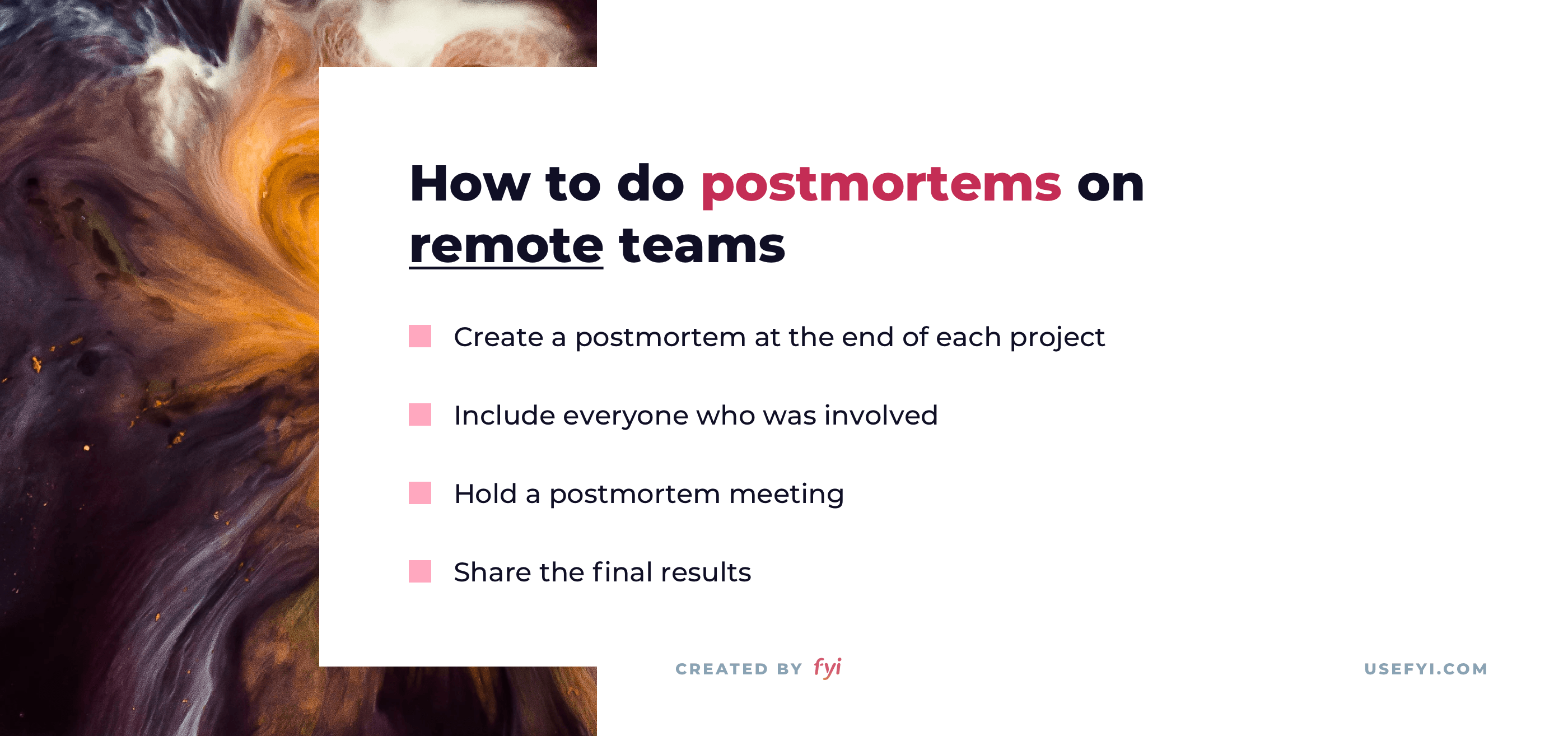
A postmortem is a written assessment that gets completed once a project is done to help assess how it went and what should happen differently next time.
Whenever a project at Nira is complete, we run through a postmortem. It could be anything from a new feature we built, a marketing initiative, or a serious bug.
Whoever was in charge of the initiative owns filling out the postmortem template with all the pertinent details of a project, and then getting insights from the rest of the team. Here’s what we include in our template:
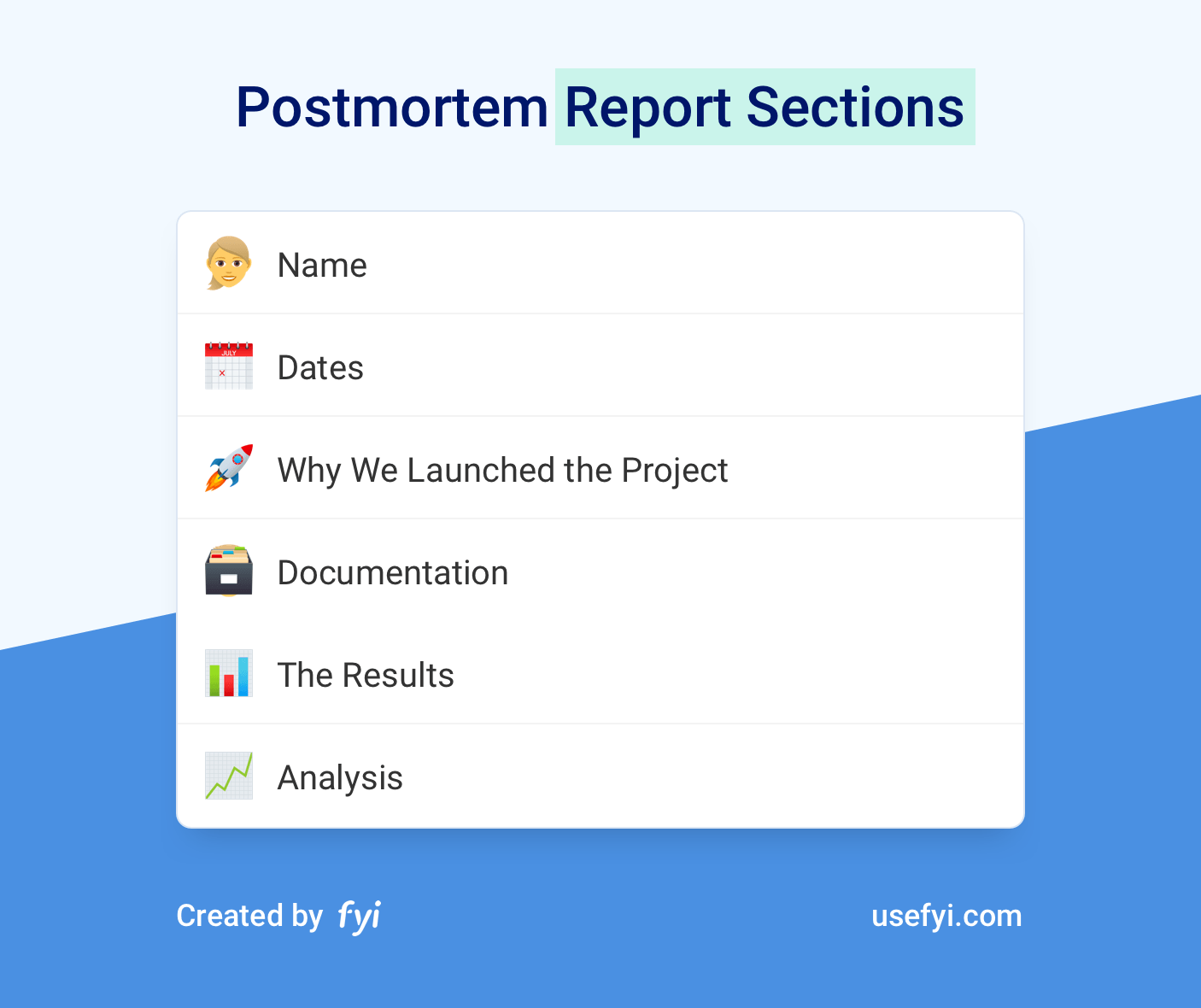
I like to focus on filling out all the nitty-gritty details of exactly what happened and why we chose to do the initiative. Once I have a good feel for that, I dive into the results of the initiative. What were the outcomes of the initiative? What went wrong along the way? Next, I go into what we should improve next time, and make sure to add action items with assignees for each one.
Here’s what we always add to the top of our postmortems to help inspire us to be honest and open about what happened:

Once the template is filled out, I make sure to go over the postmortem during a meeting with the key team members who were involved to make sure we didn’t miss anything.
For remote teams, since there aren’t any hallway conversations about how a project went, postmortems help us get everything down on paper and discussed.
Our aim in doing postmortems is to celebrate what we did, understand the results, and do even better next time. They are one of my favorite tools to use as a remote team and are great for colocated teams as well.
9) Build in accountability
Years ago when I had an office job, a manager used to come by my desk to say hello. Before he announced his presence, he’d stand behind me for a few seconds (probably much more) and scope out what I was working on. Sadly, sometimes it was Hangouts chat or Facebook Messenger. And I was caught redhanded. The fear of being caught kept me from slacking off most of the time.
That’s why remote work is great. You can chat with whoever you want, whenever you want. Instead of working, you can wash the dishes you forgot to wash the night before. Even do your laundry while you’re on a call, as long as you keep the video off.
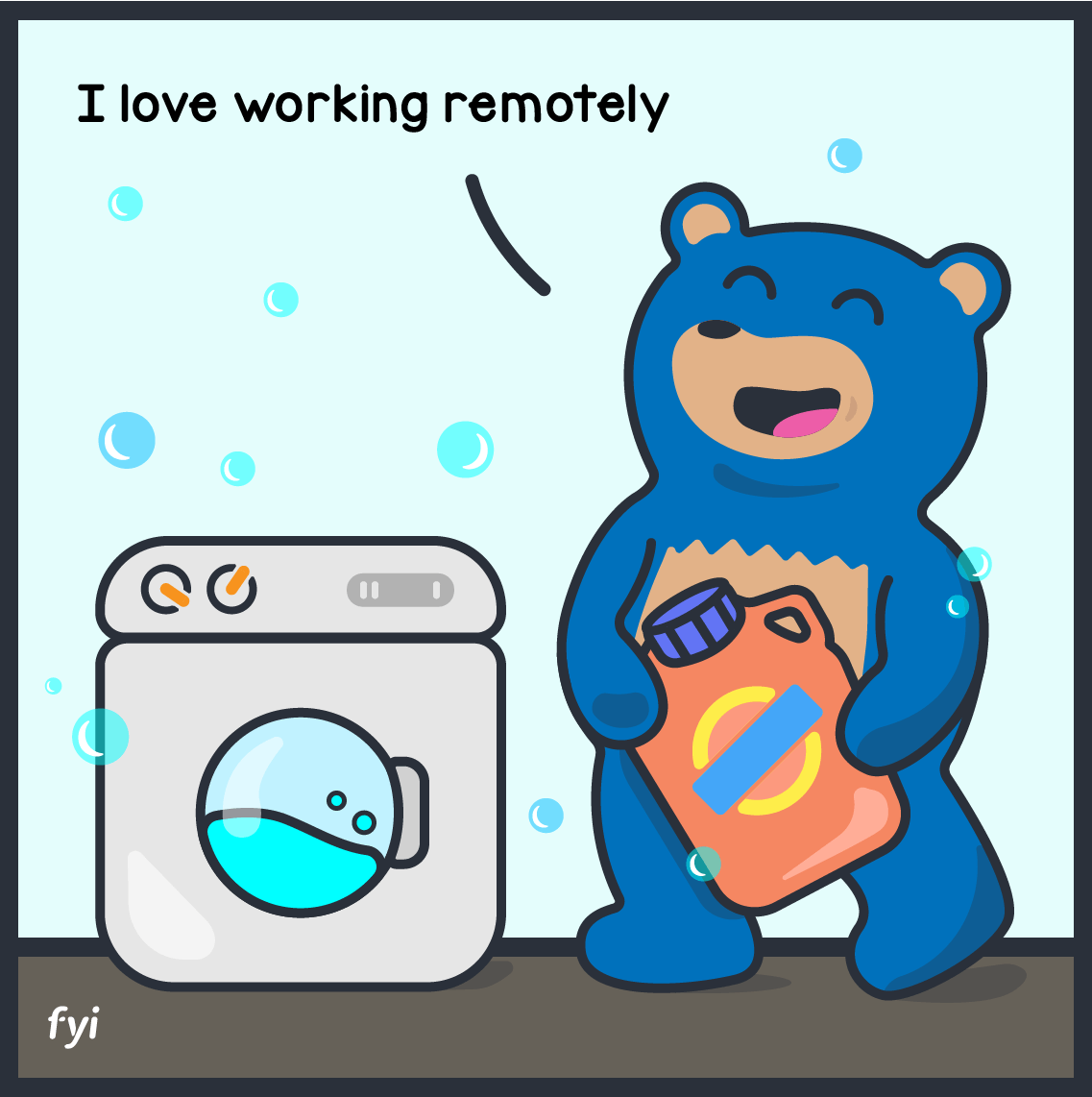
Except… socializing or doing household chores when you’re supposed to be working is a recipe for reduced productivity, longer hours, and work-induced woes.
It’s easy to fall into these traps as a remote worker. Distractions loom ominously close. And there’s no one to regulate you but yourself.
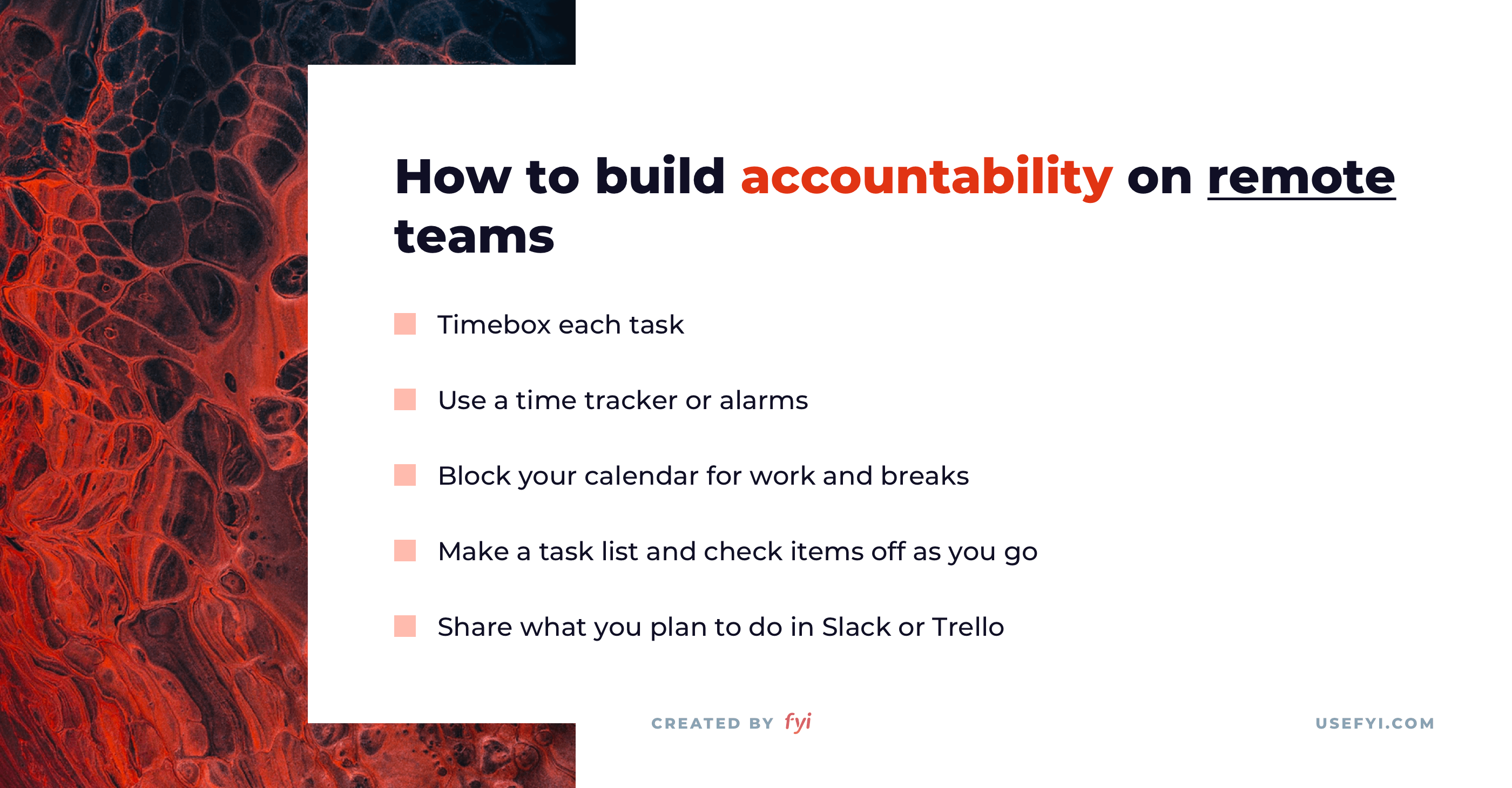
But have no fear, there are plenty of tactics you can use to become more accountable.
The first: timebox each task you’re doing. Decide how long something will take and dedicate yourself to working on it during that time.
You can also use a time tracker or alarms to help keep you on track.
Or, block your calendar off so you know when to focus on what and prevent people from scheduling meetings at that time.
“Set a schedule, including breaks, and hold yourself accountable. Personally, I use alarms on my phone to remind me when to stop. I block time in the calendar to prevent meetings from being booked during those times that I know I need a break (lunch, gym, etc.). And, I try to make a list of what I need to accomplish each day to feel like my day has been a ‘success’.”
Heather-Mae Pusztai, Customer Engagement at Buffer
Standard task lists can help you know what you’re working on for the day and check it off as you go along. Hiten and I have a shared daily checklist we each add to every day which helps us add in an extra level of accountability since someone else is seeing it.
“A lot of people struggle with accountability with remote work. I publicly commit (in Slack) to what I’m working on and when I plan to get it done. If I say something publicly, I’m more likely to get it done when I say I will.”
Melissa Bierly, Product manager at Parse.ly
Sharing what you’re planning to do in Slack will help build accountability for you and your team. If you’ve said what you’re doing, you’re much more likely to do it than face the specter of public judgment.
At Nira, we do this through what we call daily updates. We share what we accomplished the day before and what we’re planning to do today. That way we can let everyone know what we’re up to, see what others are working on, and also keep ourselves accountable for our work.
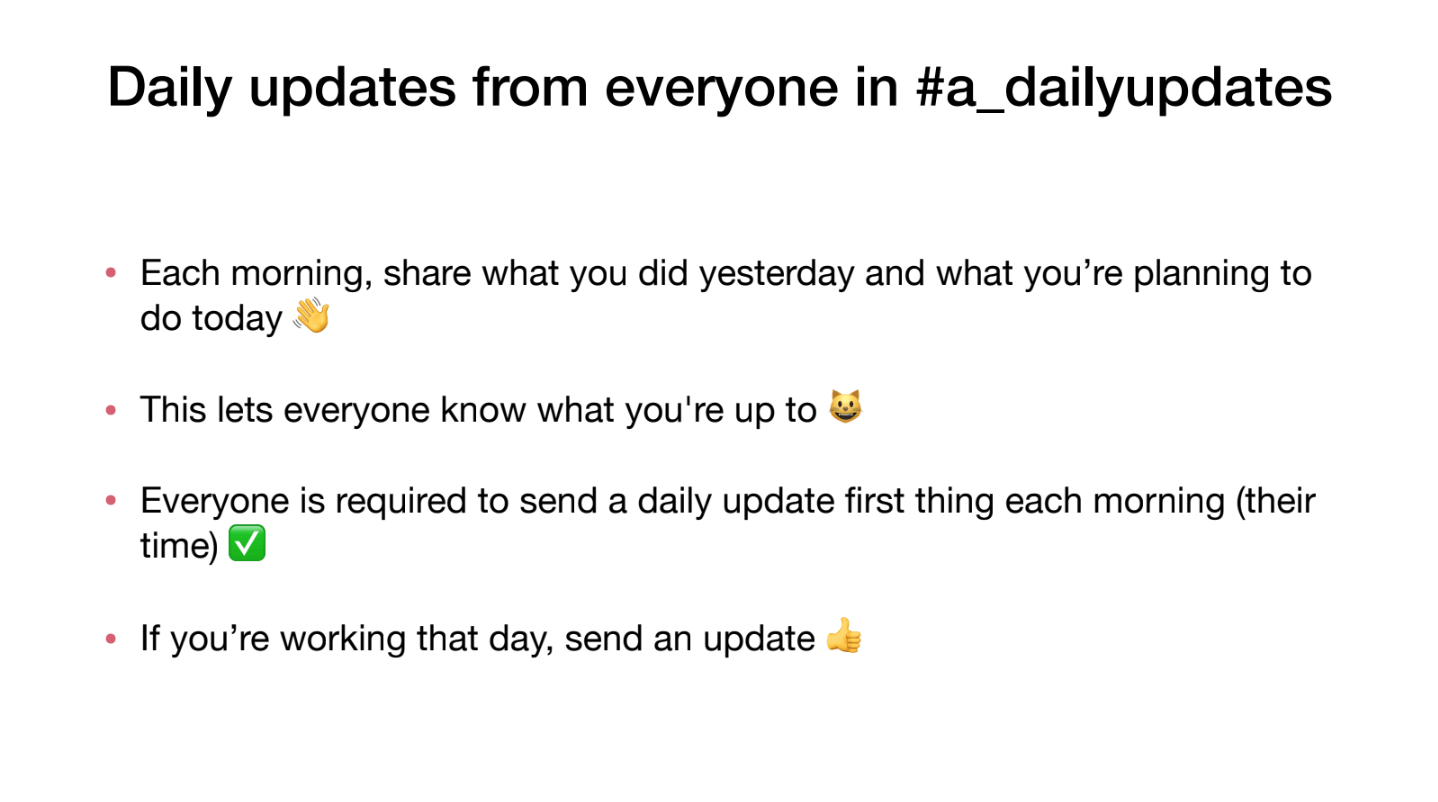
10) Define your and the team’s responsibilities
How many times have you done something, only to realize that someone else did the same thing? Or, you finished up a project and delivered it to your manager, only to hear that you didn’t do what was asked of you.
On remote teams—where communication is more challenging and things can get lost in translation—it’s important to be crystal clear about responsibilities. Otherwise, communication mishaps can happen all the time.
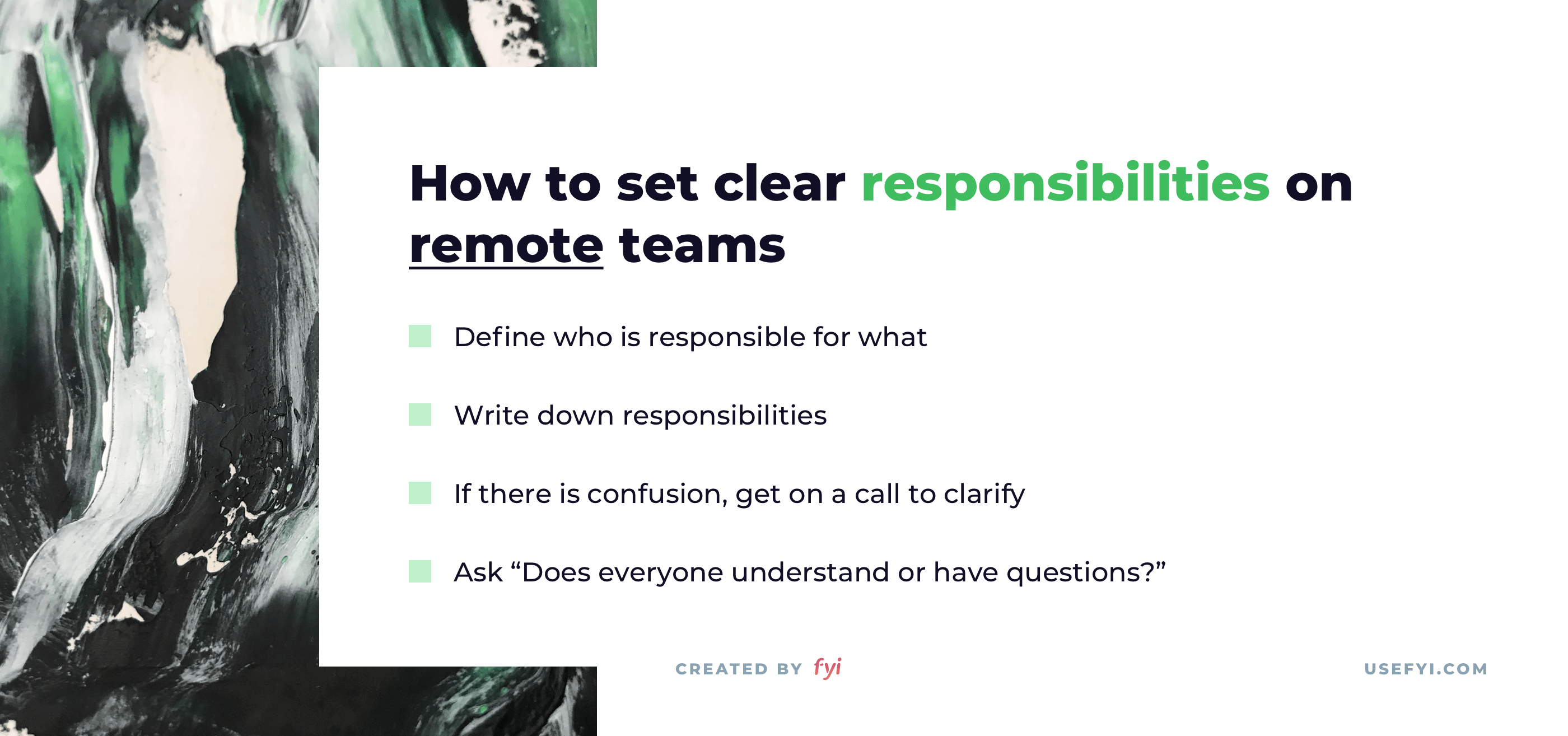
“Who is responsible for X should be obvious to everyone. When it’s not clear, you end up having more meetings, calls, emails, and conversations than you should. This is a recipe for disaster.”
David Fernández, Co-founder of Readsmart
If you find that people are confused, there are lots of unnecessary meetings happening, emails flying around, and lots of questions coming your way, it probably means responsibilities aren’t clear.
Start by defining responsibilities on a project. Then, write down who is responsible for what, and share it with the team. Getting it documented means way less confusion and wasted time.
If you’re suddenly not sure what you’re supposed to be doing, ask. Slack your manager, set up a call, make sure that you are clear about what’s expected of you. And if you’re a manager, check in with your team to find out if they understand their tasks.
“When there’s doubt about who should be working on what and what the responsibilities are, don’t try to coordinate with everyone individually. Instead, set a time to jump on a call and discuss so everyone’s on the same page. Literally ask: “does everyone understand or have any additional questions”. Often it’s your fault for not being as clear as you need to be, and saying it out loud forces you to clarify your own thoughts.”
Matt Hollingsworth, Head of Operations at We Work Remotely
11) Focus on your health
If you let it, working from home can sap your energy. I used to always go to the gym on my way home from the office. I had momentum, I had a routine, it was easy to fall into the good habit.
With remote, you’re home, so the momentum is to stay at home. It’s easiest to be in comfortable clothing, ordering take out and working around the clock. Especially when your pet is asleep on your lap.
This isn’t a trap everyone falls into. But it can happen to the best of us. And it’s easy to prevent.
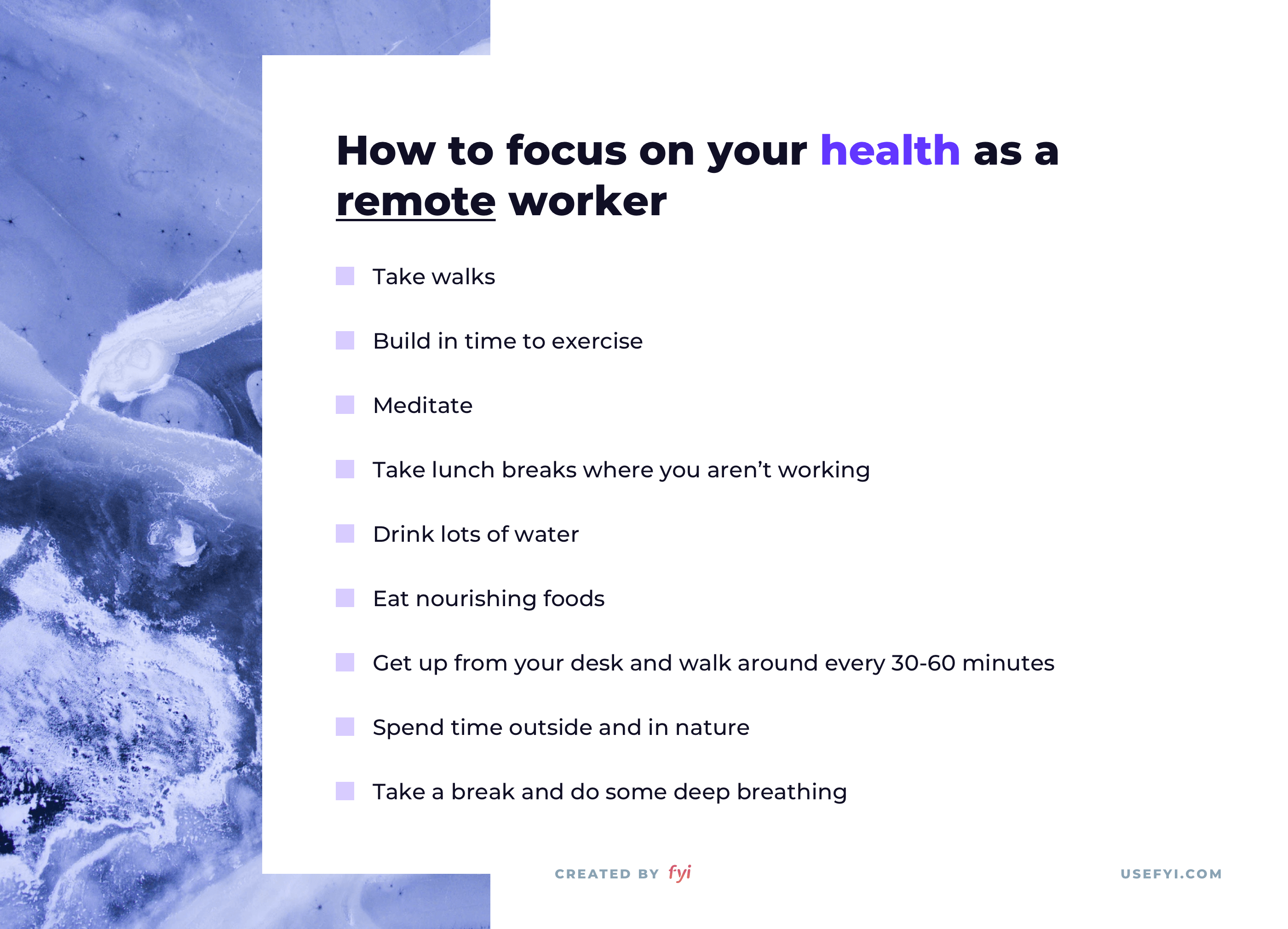
A routine can help you get into the groove of healthy activities. Once you do something a few times, you gain momentum to keep doing it. For example, taking time to go to the gym, hiking with your dog, going to a yoga class, or getting time in nature.
“Get outside every day, ensure a steady workout routine.”
Claire Atkin, Director at First Mountain
Make time for these activities, even if you take a break from the workday and finish working later.
Stay hydrated and make sure to get up from the computer every so often. Practice healthy eating habits if you can. And don’t forget about your mental health too. Make sure you celebrate wins and achievements and don’t drive yourself to exhaustion and burnout. If you need to take time for a therapist, do that. Whatever it takes for you to be healthy and happy.
“Being a workaholic, you often forget to be physically active throughout the day. I find it’s important to get up out of your desk every 30 minutes or so and just stretch and walk around a bit. Sometimes this is easier said than done because being a remote worker means there may not be anyone around to remind you to take a break once in a while. This drive often must come from within.” Will Mitbrodt, Engineering Lead at We Work Remotely
What’s next for remote work?
Remote work is nothing new. But figuring out exactly how to work remotely, that’s still cutting edge.
If you work remotely or have remote team members, these 11 best practices for working remotely should become second nature to you.
We also pulled together nearly 200 tips on remote working that you can explore. For even more remote content, we’ve put together a growing list of the best remote work resources we could find on the Internet. And, here’s a remote work statistics directory for when you want to dive deeper into remote work trends.

